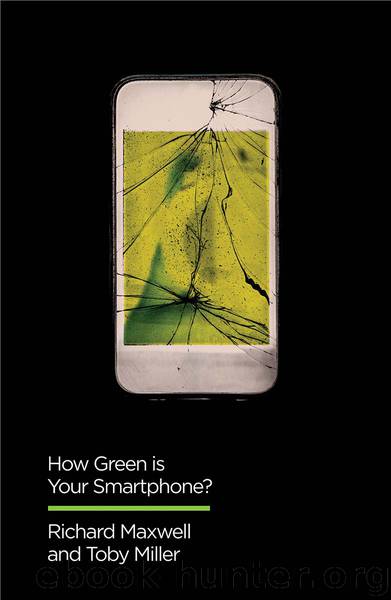How Green is Your Smartphone? by Richard Maxwell & Toby Miller

Author:Richard Maxwell & Toby Miller
Language: eng
Format: epub
ISBN: 9781509534739
Publisher: Wiley
Published: 2020-01-20T00:00:00+00:00
THREE
Calling Bullshit on Anti-Science Propaganda
So far, we’ve learned how to be smarter and more health-conscious about smartphones by understanding the risks of digital distractions and wireless radiation and appreciating the labor that both brings them to us as shiny new devices then relieves us of them when their technological sublimity has worn off. The precautionary principle serves as an excellent guide for both personal and social efforts to tame our attachment to these devices and mitigate exposure to potentially harmful electromagnetic and radiofrequency radiation. Some countries have enacted laws that strive for greater protection of cellphone users and their wireless environments.
We’ve also seen that there are three good environmental justifications for hanging onto the smartphones we already own. Doing so contributes less often to the problem of e-waste, a global disaster for ecosystems and the atmosphere; reduces carbon emissions, which are highest when new phones are manufactured and lowest over the smartphone’s useful lifetime (compared to other digital devices); and de-pressurizes market demands that systematically pull millions of young people into intensive and hazardous factory conditions, where the length of the workday and the pace of production are dictated by brand companies and their annual promotions of dubious upgrades (not to mention their lack of responsibility for dealing with discarded products).
Along the way, we’ve encountered resistance to making our smartphones and wireless environment greener and safer. We saw that the CTIA is using US courts to fight attempts by cities to share and augment the FCC’s tepid warnings about the possible carcinogenic effects of smartphones. CTIA spends millions of dollars each year convincing lawmakers that they run a safe and reasonable business. One result is that agencies like the FCC favor the very industries they were meant to regulate on our behalf, relinquishing their duty to protect us from known and potential risks. Among other things, this makes it more difficult to find scientific information about cellphone radiation, even the questionable SAR found in obscure legal notices that are posted in phones themselves. And we’ve seen how the vast majority of e-waste recycling operates in the shadows of illegality. The cellphone is a shady customer indeed, concealing the work that makes it and disposes of it, the impact it has on users, and the devastation it wreaks on miners, manufacturers, and recyclers.
Much of this hidden truth is the responsibility of propagandists for the industries involved, who operate ideologically as per the model of extractive capital. The fossil-fuel sector has been aware for decades that energy from coal and petrochemicals saturates the atmosphere with the greenhouse gases that are responsible for global warming. It has been involved in a vast, long-term propaganda campaign to deny this knowledge and cover up the extractive industries’ role in the climate crisis (Hall, 2015).
Likewise, the telecommunications industry has long been aware of mobile-phone radiation risks from research on microwave radiation, which began during World War II (Cook et al., 1980). Studies conducted in the late 1970s on microwave (non-ionizing, or thermal) radiation in the US
Download
This site does not store any files on its server. We only index and link to content provided by other sites. Please contact the content providers to delete copyright contents if any and email us, we'll remove relevant links or contents immediately.
| Coloring Books for Grown-Ups | Humor |
| Movies | Performing Arts |
| Pop Culture | Puzzles & Games |
| Radio | Sheet Music & Scores |
| Television | Trivia & Fun Facts |
Everybody Lies by Seth Stephens-Davidowitz(1650)
You're Not Listening by Kate Murphy(1551)
Sex, Drugs, and Cocoa Puffs by Chuck Klosterman(1237)
The American Scene by Henry James(1194)
The Attention Merchants by Tim Wu(1181)
Empire of Illusion by Chris Hedges(1181)
Simulacra and Simulation by Jean Baudrillard(1155)
The House of Kennedy by James Patterson(1047)
Sense of Wonder by Bill Schelly(1011)
Predictably Irrational by Dan Ariely(974)
Fast Food Nation by Eric Schlosser(954)
The 50th Law by 50 Cent & Robert Greene(953)
Free Women, Free Men by Camille Paglia(926)
What the Dog Saw: And Other Adventures by Malcolm Gladwell(857)
At Home by Bill Bryson(846)
Time Travel by James Gleick(820)
North Korea's Hidden Revolution by Jieun Baek(817)
Thank You for Arguing (Revised and Updated) by Jay Heinrichs(817)
Need to Know by Timothy Good(803)
